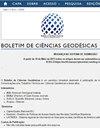沙化过程中地形特征的大比例尺制图表示
IF 0.5
Q3 Earth and Planetary Sciences
引用次数: 1
摘要
摘要在地形图中,等高线和高程点通常代表高度和坡度的变化。等高线间隔定义了浮雕表示的细节程度。我们能在地图上识别的地貌特征与等高线的泛化有关。在这项研究中,我们的目标是定义从砂化过程中绘制地形特征的必要细节水平。方法包括:通过文献综述确定研究区与砂化有关的地形特征;描述使用遥控飞机(RPA)进行数据调查以生成正射影像马赛克和数字表面模型(DSM)的各个方面;利用DSM提取不同尺度的等高线。我们定义了八个地形特征(剥蚀地貌、细沟、沟壑、微残丘、沙丘、沉积扇、集中流和沟壑),以1:5 000、1:10 000、1:500、1:20 00和1:100的比例尺在等高线地图上表示。结果表明,等高线能较好地表征地形特征的尺度。由于目前还没有合适的比例尺来表示与沙化过程有关的地貌,因此本研究可以为沙化过程发生地区的地貌研究做出贡献。本文章由计算机程序翻译,如有差异,请以英文原文为准。
LARGE-SCALE CARTOGRAPHIC REPRESENTATION OF RELIEF FEATURES FROM SANDYZATION PROCESS
Abstract: In topographic maps, contour lines and elevation points usually represent the variation of height and slope. Contour lines interval defines the level of detail for relief representation. Geomorphological features we can identify on maps are related to contour lines generalization. In this study, we aim to define the necessary level of detail for the cartographic representation of relief features from the sandyzation process. The methodology comprises: defining the relief features associated with sandyzation at the study area by literature review; describing the aspects of data survey using Remotely Piloted Aircraft (RPA) to generate the orthophoto mosaic and the Digital Surface Model (DSM); and using the DSM to extract contour lines at different scales. We defined eight relief features (denudational landform, rill, ravine, micro-residual hill, dune, depositional fan, concentrated flow, and gully) for contour cartographic representation at 1:5,000, 1:1,000, 1:500, 1:200, and 1:100 scales. The results show the scales in which the relief features have their geomorphological characteristics better represented by contours lines. Since there is no reference for suitable scales for the cartographic representation of landforms related to the sandyzation process, this study can contribute to geomorphological researches in areas where this process occurs.
求助全文
通过发布文献求助,成功后即可免费获取论文全文。
去求助
来源期刊

Boletim De Ciencias Geodesicas
Earth and Planetary Sciences-General Earth and Planetary Sciences
CiteScore
1.70
自引率
20.00%
发文量
10
审稿时长
3 months
期刊介绍:
The Boletim de Ciências Geodésicas publishes original papers in the area of Geodetic Sciences and correlated ones (Geodesy, Photogrammetry and Remote Sensing, Cartography and Geographic Information Systems).
Submitted articles must be unpublished, and should not be under consideration for publication in any other journal. Previous publication of the paper in conference proceedings would not violate the originality requirements. Articles must be written preferably in English language.
 求助内容:
求助内容: 应助结果提醒方式:
应助结果提醒方式:


